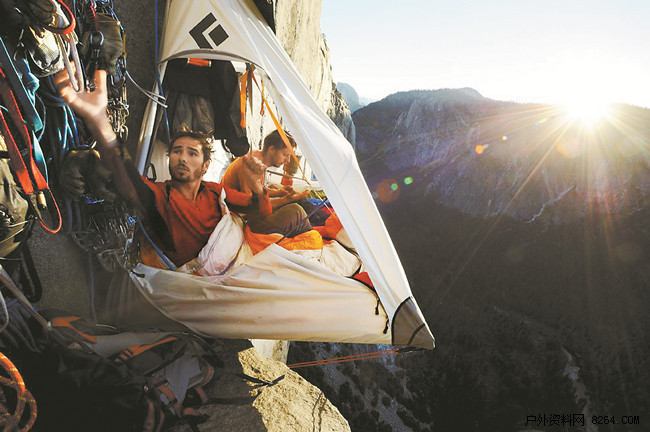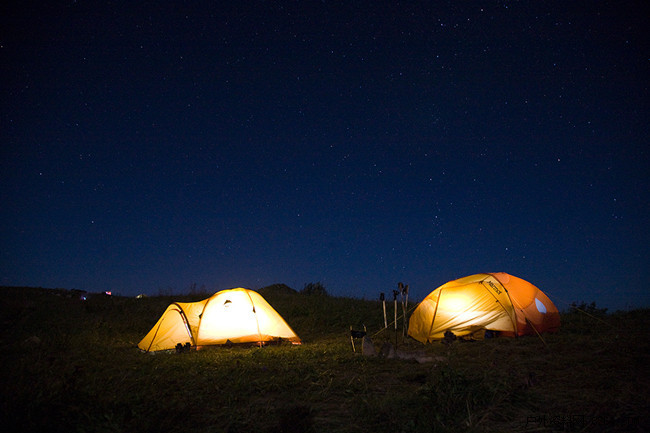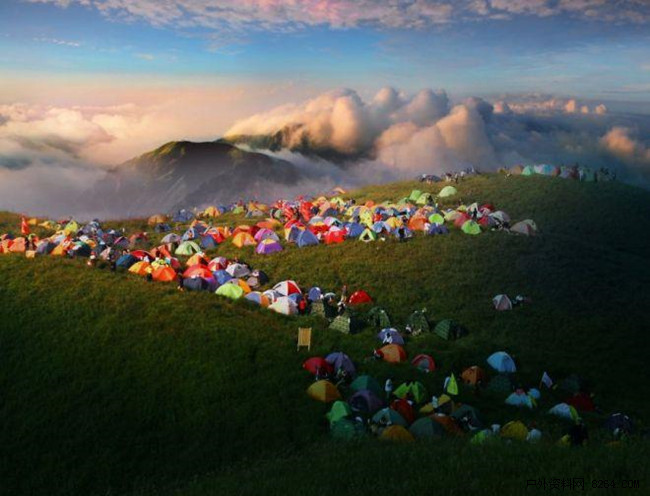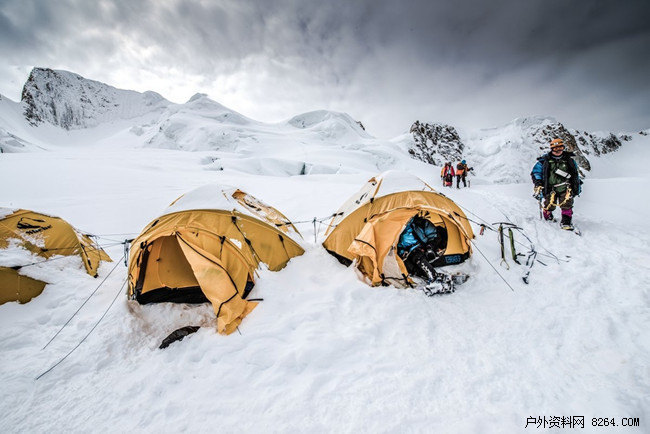If you build a tent under bad terrain

1 slope
Here is the situation that is often encountered in climbing uphill. Under normal circumstances, it is still possible to find a flat slope on the slope (if no reference is made to the third and fourth paragraphs), the key is that at night, the friction between the sleeping bag and the damp-proof pad is small, and the person will slide downwards. It is impossible to fall asleep when the slope is large.
adapting methods:
a. When two people build tents, select two camping trees under the tent. If you do not move two big stones below, put the
Backpack in the middle of the tree or stone so that you can sleep at night. On the bottom, the foot rested on the backpack at the bottom. In fact, this way the person was half asleep. I once camped on a hillside of about 30 degrees. After four hours, the soles of the feet were very uncomfortable, and the left and right feet slept alternately for one night.
b. If a person is better to solve, choose to camp on the side of the tent against a tree or a stone, place the backpack in the middle of the tree or stone, so that the weight of the person presses on the edge of the backpack, and the sleeping side can alternately Ensure better sleep.
2, the tent rod is not
This possibility is that the tent and the tent canopy are divided into open, sometimes non-dairy, and sometimes with accountant team members and players with tents and club members (this happened when a few of my friends last year wore clothing). The most common is the damage to the tent canopy. When we encounter this situation, we must make it clear that the tent canopy is actually a support for a few posts. If you are not camping in snow-capped mountains and strong winds, the strength requirement is Not great, so it is easier to find alternatives in the wild, the best is bamboo, toughness and strength. If you can't find it, use a knife to cut a wood branch that is almost the same length. The principle is to find new branches. Branches, find wet branches don't look for dry branches, such branches have greater toughness. The supplement is to see another posting that describes one of the ways to prevent lightning in the wild. It is to insert a metal tent pole into a place about ten meters away from the tent to use as a lightning rod. Obviously it is only necessary to use branches to replace the account at this time. Canopy pole.
3, the area of ​​the camp is too small (certainly less than the bottom area of ​​the tent) or too many rocks at the bottom cannot be cleaned up. This situation is more complicated and should be flexibly used according to the geographical conditions at that time.
a, if the bottom is not flat, there is no thicker floor mat that can easily tie the bad bottom. Under normal circumstances, you can look for dry grass or leaves to fill the bottom.
b. If the camping area is too small to clean up, there is no way. Only when the tent is opened, and where is the place to rest flat, the key is not to leave the bottom of the tent open, so as to avoid crushing the bottom cloth.
c. This is a special case. Once it was camped on the top of the mountain. When you found it, you found a flat ground. In the midst of the gas, there was a block of big rocks protruding from it. A knife was used to dig the roots. There was no law, and you had to sleep. Obviously, if the tent is pressed directly onto the stone, the vacant cloth is easily torn. The method adopted is to tighten the tent tent rod to support the tent as much as possible, and even find a few stones pressing the tent rod, so that the amplitude of the account canopy is larger, and the result is that the bottom cloth is not loosened and pressed. The following cloth on the stone does not collapse very tightly. When I slept with my companion at the time, the stone rested in the middle and slept sideways. Of course, if you are too bent and afraid to bend the tent pole, you can replace it with the branches as above.
4, stone seams, caves, chaos
This is a very bad situation, that is to say there is no place to camp. Then I would like to ask, the tent is used to do what, well, the first course is rain, if we can not camp without rain, then there is the second, there is a certain warm effect, well, if Your sleeping bag can meet the temperature requirements. Then why do we have to camp? Let's sleep. Of course, there are sometimes worm harassment. It's not very serious. If the weather is extremely bad, uh, what unlucky things make you run into it, only with the last trick! First of all, the inner tent wraps the moisture-proof pad and the sleeping bag. Of course, the inside space should be as large as possible, put the clothes or some articles on the top of the head, so that the head part of the cloth should be supported for breathing, and then the foreign account should be covered. Well, a waterproof, warm, pest-proof nest is built.
In the above situations, I just initiated the project. I believe there are other ways. Of course, the most important thing is to make detailed plans for each trip. The numbers of water sources, camp sites, and teams should all be considered clearly. Think of the difficulties and accidents ahead of time, and don't start to panic when things finally happen. The camping situation in the harsh environment of the field is relatively complex. It is necessary to adapt the geographical environment to local conditions and use it flexibly to ensure a high quality of sleep and to reserve physical strength for the next day's mountaineering.
The tent is a very important equipment for those who engage in outdoor activities, especially in the case of bad weather, no shelter in front of the village, and no shelter in the store. A tent with good wind and shelter can be reassuring. Wait for the advent of good weather. But did you throw the tent into your storage cabinet or into the trunk of the car after you got home? If so, I suggest you read the instructions below and hurry to get your cute tent out and tidy up!
Any durable tent has its useful life. Proper maintenance and care can increase the service life of the tent, and the method of use is actually very simple:
When you bought a new tent from the outdoor shop and returned home, remember to put a suture on the waterproof seam of the tent. Why? Since the tents are completed and delivered to the store and then to your hands, we do not know how much time has passed between them. Although you may have undergone detailed inspections in the store and feel that the tents have no shortcomings, they have to be comfortable. Good feeling, do waterproof measures again!
Practice putting up your tent! "If a worker wants to do something good, he must first sharpen his tools." If you arrive at the camp, you will not build your own tent. This is not a big deal! Familiar with your own tent can help you not be at a loss when you encounter unexpected situations. Incorrect building tents can easily cause damage to the tent.
Keep tents dry as much as possible, and then close the tent! After finishing the outdoor trip, remember to hang the tent and dry it. If the tent is a little dirty, gently brush it with cold water! Do not use chemical lotion, or scrub hard, this will destroy the waterproof film on the surface of the fabric, reducing the waterproof effect of the tent. The mildew in the tent will destroy the waterproofness of the tent. In the event of moldy conditions, use a sponge with a little detergent to gently brush the mold.
When camping in the wild:
Choose a flat camp and clear out the projections on the camp as much as possible. This avoids discomfort on the back while sleeping and prevents the tent from being punctured.
Prepare additional ground cloths and lay the ground cloths under the tents, inside or outside the tents. But on the outside, not only can the tents be kept clean, but also the stones or branches on the ground can be prevented from damaging the ground cloths of the tents themselves. . When entering the tent, do not wear shoes. The ultraviolet rays of the sun will destroy the fabric strength of the tent. If there is no extra shade in the camp to cover the tent, it is recommended that you put up a tarpaulin to cover the sun and avoid direct sunlight to the tent.
When setting up tents, it is best to use camping nails to fix the tents on the ground. Although most of the tents nowadays can be built independently without the need for nailing, the power of nature is limitless. Do not assume that there are people in the tents or backpacks. It's okay to escort. According to the author's experience, when the nature shows its strength, the tent runs along with the people inside it! Make sure your tent ventilation is good! Because we sleep at night, body sweat and exhalation will increase the humidity of the air inside the tent. Assuming that four people sleep in a tent, one night can accumulate up to 1 liter of water if the tent is not good. The ventilation, surely the four people's sleeping bags and sleeping mats were all wet in the morning.
Before you close the tent, make sure that nothing or debris is left behind.
When combining battalion columns, the old ones can be combined in one section, and do not use the throwaway combination. When dismantling the camp column, dismantle it from the middle and remove the two ends, so as to maintain the elasticity of the elastic cord.
Do not use the same method to fold the inner draperies and ponchos during collection. This will speed up the damage of the crease part of the fabric, and it is better to fold them in different ways each time.
Tent patching
After the tent is used for many times, it will surely be damaged, and usually there will be damaged parts, mostly leaking from the seams, holes in the tarpaulin, and seepage of the ground cloth. These damages can be repaired. In addition, the bursting and damage of the battalion pillars are usually replaced by new pillars directly, so they are not mentioned here.
The following is a brief introduction of the suture glue processing method:
Surgical treatment
When doing waterproofing of sutures, first determine if waterproofing is needed, because not every suture needs to be treated with suture glue. Usually it is exposed to rainwater. The suture on the puddle needs suture glue. Therefore, the suede of the tarpaulin and the ground cloth must be waterproof. As for the inner wall of the inner account, it will not be in direct contact with the rainwater.
The next step is to decide on which side to do the suture treatment. Usually it is usually on the inner side of the rain cloth and the ground cloth. It is correct to say that it should be on the other side of the waterproof membrane, that is, the side that does not have the waterproof membrane treatment. Suture glue. The easiest way is to drop some water on the surface of the cloth. If you still keep the shape of the water droplets, there will be a waterproof membrane covering it. If the water will spread out, it is your goal.
The next step is to start applying sutures, prepare a clean and dry toothbrush, remove the old bristles, and apply suture to the sutures. After the suture is dry, tighten the fabric. The suture is stretched so that the suture can penetrate. Wait another hour and wait until the suture is completely dry! Finally, use a sprinkler to determine if it will not leak. If there is water leakage, repeat the previous four steps after the fabric is completely dry!
Remove the musty taste of the tent

A musty smell and/or a small cross spot on the tent fabric indicate that the tent is moldy. Mold can only grow in a dark, moist and warm environment (the dirt will provide nutrients). The fungus actually passes through the polyurethane coating of the tent fabric, then grows between the fabric and the coating, and finally destroys the fabric. This damage is irreparable, but if you take immediate action, you can prevent the further growth of mold, to prevent even more damage. If the tent starts to mold, put it up, scrub it with warm soapy water and sponge, and then use a piece of Clean the sponge dry. Sponge with a half cup of Lysol solution and one gallon of hot water. Let the solution stay on the surface of the fabric and allow it to air dry. Then, mix a glass of salt, a glass of concentrated lemon juice and hot water, knead the solution into the visible mold, and let it dry. In this way, mold growth can be prevented and mildew can be eliminated, but mold traces cannot be removed. The damage caused by moulding is not covered by the warranty. These methods are provided only to extend the life of the tent when it is moldy.
Reasonable storage for return

The tents are necessary equipment for outdoor camping. As we all know, the tent fabrics mainly consist of PU coating and silicon coating, and most of the tent seams are made of waterproof rubber strips for waterproof purposes.
As the tent uses waterproof tape, folding and storage will cause the waterproof tape to bend and be pressed by external force, which will easily cause the tape to fall off.
However, due to the large size of the tents, under normal conditions, it is impossible to suspend and store the tents. Then what should we pay attention to when we store the tents? The military brother hereby reminds you:
1. After the tent is in use, in addition to cleaning the dust and attachments in time, the moisture on both sides of the fabric should also be wiped off, and after the tent is completely dried, it should be folded and stored. This is very important. If not stored completely dry, it is easy to make the fabric mildew and adhesion problems. Affect the life of the tent!
2. After the tent is completely dry, folded and stored, try not to press other items on the tent so as not to cause permanent fatigue and degumming of the waterproof strip material. (Personal experience is to find a carton specifically for tents). I think many of my friends are not just one tent. Special storage is also conducive to the induction of equipment.
3, regular or irregular out of the tent to cool out of the sun (to avoid direct sunlight) for a long time, rearranged and then folded and stored, this has the advantage is to prevent the tent fabric mildew and adhesion, but also to make the tent bent waterproof Pressure strips do not produce permanent fatigue, extending the overall life of the tent.
4. After the tent is cleaned up, it is not advisable to use the original storage bag for compact storage.
By the way, playing equipment is a process of enjoyment. This process is not a simple “burning equipment.†It is also a pleasure to sort out the equipment in peacetime.



